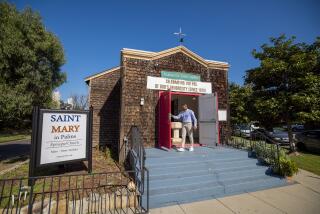Low-Income Housing Goal of O.C. Group : Coalition: Bankers and community and public agencies will provide a ‘clearinghouse,’ believed to be the first in California.
SANTA ANA — A coalition of Orange County community groups, public agencies and bankers Thursday announced the formation of a nonprofit organization dedicated to developing affordable housing for low-income residents.
Sixteen of the county’s leading financial institutions have pledged $162,000 over the next two years to form and staff an affordable-housing “clearinghouse”--believed to be the first of its kind in California.
The agency will attempt to put together financing packages and provide technical assistance for housing geared to low-income, very low-income and special-needs residents, such as seniors and the disabled, in what is one of the most expensive housing markets in the nation.
The projects are expected to include homeless shelters, apartments for the disabled, large apartments for families with children and single-family homes.
Participants, speaking at a press conference in the offices of the Orange County Human Relations Commission, said they believe that the clearinghouse marks an unprecedented effort to build more low-cost housing in an area that has traditionally spurned such developments.
Sponsors say the clearinghouse will be the first centralized group in the county with ties to the banking, housing and nonprofit communities, as well as local governments, and thus will greatly ease the building of affordable units.
“The breadth and scope of participation . . . is both unique and exciting,” said Joe Caux, speaking on behalf of the Fair Housing Council of Orange County. “The needs are clear. The clearinghouse won’t in itself solve the affordable housing crisis, but it has the potential to be a very effective tool.”
The clearinghouse has already formed a board of directors and is looking for an executive director, said Mary Ann Gaido, a housing expert with the Human Relations Commission, which orchestrated the new partnership.
Bankers said they expect the clearinghouse to help identify particular housing needs in their communities that might otherwise be neglected.
Federal regulations require financial institutions to “seek out and address community credit needs in areas where they do business.” Those regulations for the most part lay on the shelf until recent legislation beefed up the requirements and opened up banking records to the public, officials said.
“The regulators say to go out and find needs in the community, but they don’t tell us how to do it,” said Robert P. Zingg, president of Colonial Bank in Santa Ana. “This brings together all levels of expertise.”
Clearinghouse members--from banks such as American Savings, Sunwest and Sumitomo to community groups such as the Salvation Army--have already identified a number of projects in the early stages of planning that may be ripe for development.
James Davis, senior loan manager at Plaza Savings, said one--a 40-unit senior housing project in Garden Grove--appeared to be too risky for his bank to fund alone. But through the clearinghouse, he said, other lenders might be found to share the burden.
“We’re going to toss it into the ring for consideration, and if approved, we could see ground-breaking by December,” he said.
The new effort comes at a time when government money for affordable housing is declining while the need for such housing is rising.
A 1990 report by the private California Coalition for Rural Housing found that overall, only 24% of the county’s low-income housing needs had been met. According to the study, the county should have more than 40,000 units of low-income housing to shelter poor residents but has produced fewer than 9,500 units.
The study found that some cities--Buena Park, Fountain Valley and Los Alamitos--had produced no low-income housing at all.
Housing authorities estimate that more than 18,000 county families are on waiting lists for low-income housing.
The needs are fueled by housing prices that are among the highest in the nation. As of March, only about 21% of the county’s households could afford the median home price of $238,600, according to a recent study by the California Assn. of Realtors.
By contrast, nationwide, more than half of the families could afford the median house price of $96,500.
Likewise, the median rent in the county hovers at nearly $730 and housing authorities estimate that only .7% of the housing stock is available at $500 or less.
Experts say the combination of high housings costs and a lack of affordable housing has spawned a local homeless population estimated at more than 10,000 over the course of a year.
“In Orange County the concentration of wealth tends to mask the problem,” said Toni Dwyer, director of the Orange County Homeless Issues Task Force. “A major solution to the problem of homelessness--affordable homes--is often overlooked.”
Housing authorities believe that the severity of the problem in Orange County will attract the involvement of local governments--which in the past have been reluctant to embrace low-income housing. But clearinghouse members say they also expect to encounter some resistance from communities that may fear that low-income housing will drive down housing values or attract “unwelcome elements” to the community.
“It’s inevitable that will happen,” Dwyer said. “But this is the first time we really have the backing of the banking community. They have a voice and acceptance in the community that the nonprofits don’t have.”
More to Read
Sign up for Essential California
The most important California stories and recommendations in your inbox every morning.
You may occasionally receive promotional content from the Los Angeles Times.











